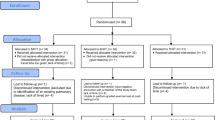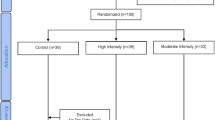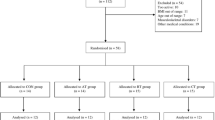Abstract
Purpose
The effect of exercise intensity and sex on postprandial risk factors for cardiovascular disease in adolescents is unknown. We examined the effect of a single bout of work-matched high-intensity interval exercise (HIIE) and moderate-intensity exercise (MIE) on postprandial triacylglycerol (TAG) and systolic blood pressure (SBP) in adolescents.
Method
Twenty adolescents (10 male, 14.3 ± 0.3 years) completed three 1-day trials: (1) rest (CON); (2) 8 × 1 min cycling at 90 % peak power with 75 s recovery (HIIE); (3) cycling at 90 % of the gas exchange threshold (MIE), 1 h before consuming a high-fat milkshake (1.50 g fat and 80 kJ kg−1). Postprandial TAG, SBP and fat oxidation were assessed over 4 h
Results
Compared to CON, the incremental area under the curve for TAG (IAUC-TAG) was not significantly lowered in HIIE [P = 0.22, effect size (ES) = 0.24] or MIE (P = 0.65, ES = 0.04) for boys. For girls, HIIE and MIE lowered IAUC-TAG by 34 % (P = 0.02, ES = 0.58) and 38 % (P = 0.09, ES = 0.73), respectively, with no difference between HIIE and MIE (P = 0.74, ES = 0.14). Changes in TAG were not related to energy expenditure during exercise or postprandial fat oxidation. Postprandial SBP (total-AUC pooled for both sexes) was lower in HIIE compared to CON (P = 0.01, ES = 0.68) and MIE (P = 0.02, ES = 0.60), with no difference between MIE and CON (P = 0.45, ES = 0.14).
Conclusion
A single bout of HIIE and MIE, performed 1 h before an HFM, can meaningfully attenuate IAUC-TAG in girls but not boys. Additionally, HIIE, but not MIE, may lower postprandial SBP in normotensive adolescents.



Similar content being viewed by others
Abbreviations
- 95 % CI:
-
95 % confidence intervals
- CON:
-
Control
- CVD:
-
Cardiovascular disease
- EE:
-
Energy expenditure
- ES:
-
Effect size
- HFM:
-
High-fat meal
- HIIE:
-
High-intensity interval exercise
- HR:
-
Heart rate
- IAUC:
-
Incremental area under the curve vs time
- MIE:
-
Moderate-intensity exercise
- PPH:
-
Postprandial hypertension
- PPL:
-
Postprandial lipaemia
- RMR:
-
Resting metabolic rate
- SBP:
-
Systolic blood pressure
- TAG:
-
Triacylglycerol
- TAUC:
-
Total area under the curve vs time
- \({\dot{{V}}}\)O2 :
-
Oxygen consumption
References
Barker AR, Williams CA, Jones AM, Armstrong N (2011) Establishing maximal oxygen uptake in young people during a ramp cycle test to exhaustion. Br J Sports Med 45:498–503
Barwell ND, Malkova D, Leggate M, Gill JM (2009) Individual responsiveness to exercise-induced fat loss is associated with change in resting substrate utilization. Metabolism 58:1320–1328
Berenson GS, Srinivasan SR, Bao W, Newman WP 3rd, Tracy RE, Wattigney WA (1998) Association between multiple cardiovascular risk factors and atherosclerosis in children and young adults. The Bogalusa Heart Study. N Engl J Med 338:1650–1656
Carstensen M, Thomsen C, Hermansen K (2003) Incremental area under response curve more accurately describes the triglyceride response to an oral fat load in both healthy and type 2 diabetic subjects. Metabolism 52:1034–1037
Cohen J (1988) Statistical power analysis for the behavioural sciences. Lawrence Erlbaum, Hillsdale
Couillard C et al (1999) Gender difference in postprandial lipemia: importance of visceral adipose tissue accumulation. Arterioscler Thromb Vasc Biol 19:2448–2455
Frayn KN (1983) Calculation of substrate oxidation rates in vivo from gaseous exchange. J Appl Physiol 55:628–634
Freese EC, Levine AS, Chapman DP, Hausman DB, Cureton KJ (2011) Effects of acute sprint interval cycling and energy replacement on postprandial lipemia. J Appl Physiol 111:1584–1589
Gill JM, Herd SL, Hardman AE (2002) Moderate exercise and post-prandial metabolism: issues of dose-response. J Sports Sci 20:961–967
Henderson GC, Krauss RM, Fattor JA, Faghihnia N, Luke-Zeitoun M, Brooks GA (2010) Plasma triglyceride concentrations are rapidly reduced following individual bouts of endurance exercise in women. Eur J Appl Physiol 109:721–730
Hopkins WG, Marshall SW, Batterham AM, Hanin J (2009) Progressive statistics for studies in sports medicine and exercise science. Med Sci Sports Exerc 41:3–13
Horton TJ, Commerford SR, Pagliassotti MJ, Bessesen DH (2002) Postprandial leg uptake of triglyceride is greater in women than in men. Am J Physiol Endocrinol Metab 283:E1192–E1202
Katsanos CS, Grandjean PW, Moffatt RJ (2004) Effects of low and moderate exercise intensity on postprandial lipemia and postheparin plasma lipoprotein lipase activity in physically active men. J Appl Physiol 96:181–188
Kolifa M, Petridou A, Mougios V (2004) Effect of prior exercise on lipemia after a meal of moderate fat content. Eur J Clin Nutr 58:1327–1335
Magkos F, Patterson BW, Mohammed BS, Klein S, Mittendorfer B (2007) Women produce fewer but triglyceride-richer very low-density lipoproteins than men. J Clin Endocrinol Metab 92:1311–1318
Mittendorfer B, Patterson BW, Klein S (2003) Effect of sex and obesity on basal VLDL-triacylglycerol kinetics. Am J Clin Nutr 77:573–579
Miyashita M, Burns SF, Stensel DJ (2008) Accumulating short bouts of brisk walking reduces postprandial plasma triacylglycerol concentrations and resting blood pressure in healthy young men. Am J Clin Nutr 88:1225–1231
Morris NM, Udry JR (1980) Validation of a self-administered instrument to assess stage of adolescent development. J Youth Adolesc 9:271–280
Motl RW, Dishman RK, Saunders R, Dowda M, Felton G, Pate RR (2001) Measuring enjoyment of physical activity in adolescent girls. Am J Prev Med 21:110–117
Nordestgaard BG, Benn M, Schnohr P, Tybjaerg-Hansen A (2007) Nonfasting triglycerides and risk of myocardial infarction, ischemic heart disease, and death in men and women. JAMA 298:299–308
Pedersen A, Marckmann P, Sandstrom B (1999) Postprandial lipoprotein, glucose and insulin responses after two consecutive meals containing rapeseed oil, sunflower oil or palm oil with or without glucose at the first meal. Br J Nutr 82:97–104
Petitt DS, Arngrimsson SA, Cureton KJ (2003) Effect of resistance exercise on postprandial lipemia. J Appl Physiol 94:694–700
Pfeiffer M, Wenk C, Colombani PC (2006) The influence of 30 min of light to moderate intensity cycling on postprandial lipemia. Eur J Cardiovasc Prev Rehabil 13:363–368
Riddoch CJ et al (2007) Objective measurement of levels and patterns of physical activity. Arch Dis Child 92:963–969
Sedgwick MJ, Morris JG, Nevill ME, Tolfrey K, Nevill A, Barrett LA (2012) Effect of exercise on postprandial endothelial function in adolescent boys. Br J Nutr 110:1–9
Seip RL, Semenkovich CF (1998) Skeletal muscle lipoprotein lipase: molecular regulation and physiological effects in relation to exercise. Exerc Sport Sci Rev 26:191–218
Sisson S, Anderson AE, Short KR, Gardner AW, Whited T, Robledo C, Thompson DM (2013) Light activity following a meal and post-prandial cardiometabolic risk in adolescents. Pediatr Exerc Sci 25:347–359
Slaughter MH, Lohman TG, Boileau RA, Horswill CA, Stillman RJ, Van Loan MD, Bemben DA (1988) Skinfold equations for estimation of body fatness in children and youth. Hum Biol 60:709–723
Stary HC (1989) Evolution and progression of atherosclerotic lesions in coronary arteries of children and young adults. Arteriosclerosis 9:I19–I132
Stringer W, Casaburi R, Wasserman K (1992) Acid-base regulation during exercise and recovery in humans. J Appl Physiol 72:954–961
Thackray AE, Barrett LA, Tolfrey K (2013) Acute high-intensity interval running reduces postprandial lipemia in boys. Med Sci Sports Exerc 45:1277–1284
Tolfrey K, Doggett A, Boyd C, Pinner S, Sharples A, Barrett L (2008) Postprandial triacylglycerol in adolescent boys: a case for moderate exercise. Med Sci Sports Exerc 40:1049–1056
Tolfrey K, Bentley C, Goad M, Varley J, Willis S, Barrett L (2012) Effect of energy expenditure on postprandial triacylglycerol in adolescent boys. Eur J Appl Physiol 112:23–31
Tolfrey K, Engstrom A, Murphy C, Thackray A, Weaver R, Barrett LA (2013) Exercise energy expenditure and postprandial lipaemia in girls. Med Sci Sports Exerc 46:239–246
Tolfrey K, Thackray AE, Barrett LA (2014) Acute exercise and postprandial lipemia in young people. Pediatr Exerc Sci 26:127–137
Trombold JRPD, Christmas KM, Machin DR, Kim IY, Coyle EF (2013) acute high-intensity endurance exercise is more effective than moderate-intensity exercise for attenuation of postprandial triglyceride elevation. J Appl Physiol 114:792–800
Uetani E et al (2012) Postprandial hypertension, an overlooked risk marker for arteriosclerosis. Atherosclerosis 224:500–505
Vogel RA, Corretti MC, Plotnick GD (1997) Effect of a single high-fat meal on endothelial function in healthy subjects. Am J Cardiol 79:350–354
Weiss EP, Fields DA, Mittendorfer B, Haverkort MA, Klein S (2008) Reproducibility of postprandial lipemia tests and validity of an abbreviated 4-h test. Metabolism 57:1479–1485
Whyte LJ, Ferguson C, Wilson J, Scott RA, Gill JM (2012) Effects of single bout of very high-intensity exercise on metabolic health biomarkers in overweight/obese sedentary men. Metabolism 62:212–219
Yelling M, Lamb KL, Swaine IL (2002) Validity of a pictorial perceived exertion scale for effort estimation and effort production during stepping exercise in adolescent children. Eur Phys Edu Rev 8:157–175
Zakrzewski JK, Tolfrey K (2012) Acute effect of Fatmax exercise on the metabolism in overweight and nonoverweight girls. Med Sci Sports Exerc 44:1698–1705
Zhang JQ, Thomas TR, Ball SD (1998) Effect of exercise timing on postprandial lipemia and HDL cholesterol subfractions. J Appl Physiol 85:1516–1522
Zilversmit DB (1979) Atherogenesis: a postprandial phenomenon. Circulation 60:473–485
Acknowledgments
We thank the staff and participants at Exmouth Community College, Devon, UK for their participation in this project. This study was supported by the Sport and Health Sciences Research Committee, College of Life and Environmental Sciences, University of Exeter.
Conflict of interest
The authors confirm the absence of any conflicts of interest.
Author information
Authors and Affiliations
Corresponding author
Additional information
Communicated by Massimo Pagani.
Rights and permissions
About this article
Cite this article
Bond, B., Williams, C.A., Isic, C. et al. Exercise intensity and postprandial health outcomes in adolescents. Eur J Appl Physiol 115, 927–936 (2015). https://doi.org/10.1007/s00421-014-3074-8
Received:
Accepted:
Published:
Issue Date:
DOI: https://doi.org/10.1007/s00421-014-3074-8




